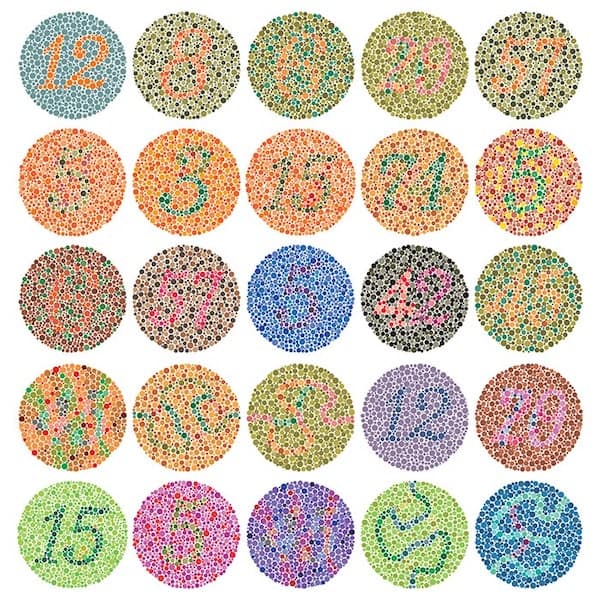How can I know if my child is colorblind?
My father is a retired high school art teacher. One day he gave his students an assignment to create something larger than life out of clay. One of his students made a huge hotdog. My father was very impressed but confused as to why the hotdog was painted green. It turned out that the student had an undiagnosed color deficiency.
According to Prevent Blindness, it is estimated that 8% of males and less than 1% of females have color vision problems. Often times left undiagnosed until later in life.
Someone with color vision problems is not truly “blind,” but does not see colors the same as someone with normal color vision. The term colorblind can also be called color deficient or a color deficiency (I will use these words interchangeably).
Learning colors can be very difficult for a child with color deficiency. A child who is colorblind will see colors differently, but they can usually judge color by the brightness or by identifying an object. For instance, if your son knows that a banana is yellow, he will always say that a banana is yellow.
If you are suspicious of a color deficiency or have a family history of colorblindness bringing your child into the eye doctor is the best way to get a diagnosis.
Color vision deficiencies can come in varying degrees from mild to severe.
A doctor will have the child look at Ishiihara pseudoisochromatic plates that have different colored numbers and patterns. Even if your child cannot identify numbers they can use a soft cotton swab to trace the outline of what they see. You can use the following picture, but the color may be different depending on the screen brightness and hue. Try to keep your screen as true to color as possible when using these colored plates.

Color Vision Restrictions
Unfortunately, there are some careers that require normal color vision to perform. Educating your child with a color vision deficiency on limitations can help them when considering career options.
The following jobs require a color vision test:
- Pilots
- Firefighters
- Law enforcement
(Some people with mild color deficiencies can still pass the color vision test)
Jobs that could be difficult for someone with a color deficiency:
- Chef: checking meat by the color would be difficult as well as checking for rancid meat, knowing if fruits or vegetables are ripe would be based on feel instead of color.
- Electrician: colored wires
- Medical field: colored lab/test results, detection of blood, rashes, jaundice, medications
- Designer
- Hairdresser
Someone with a color deficiency could have trouble with the following:
- Deciphering the colors on a traffic signal, however, they accommodate by using the placement of the lights to know when to stop or go.
- Knowing if they are sunburned or have a rash
- Picking out clothes that match
- Differentiating medications by color
- Colored graphs or charts
- Trash can colors could look the same (recycle vs trash)
- Images with poor contrast could be difficult to see

The photo of the apples from wikipedia give an example of how someone with normal color vision would view the two apples on top and how someone who is colorblind would see the two apples below.
Causes of Color Deficiency
Inherited Color Deficiency
Usually, color deficiency is inherited. These type of color deficiencies pose no threat to vision, but could hinder someone from going into certain professions.
Red-Green color deficiency is the most common inherited color deficiency and is linked to the X-chromosome. You may remember learning about X and Y chromosomes back in school. A boy receives an X chromosome from his mother and a Y chromosome from his father; whereas a girl receives an X chromosome from both parents.
Since a girl has two X chromosomes both X chromosomes would need to have the color deficiency gene for her to present with a color vision deficiency. A girl can be a carrier of the color deficient gene, but not exhibit signs of color deficiency if she receives a color deficient X chromosome from only one parent.
A boy, however, can be color deficient if his mother had the color deficient gene (even if she was only a carrier and did not exhibit color deficiency).
Aquired Color Deficiency
Acquired color deficiencies are less common than hereditary deficiencies. They are usually associated with a disease or medication toxicity.
Unlike inherited color deficiency, acquired color deficiency can affect males and females equally and can be present in one or both eyes.
Aquired color deficiency can change over time and present with recent color naming errors.
Causes for Acquired Color Deficiency
- Systemic Medications
- Diseases
- Chemical Exposure
- Age
Medications that can cause Color vision changes
| Medication | Uses | Ocular side effects | Symptoms |
| Hydroxy-chloroquine, Chloroquine, Plaquenil | arthritis, COVID-19 | Macular degeneration | color vision changes, progressive visual distortion, loss of vision |
| Ethambutol (Myambutol) | pulmonary tuberculosis | optic or retrobulbar neuritis | decreased vision or peripheral vision defects, color vision changes |
| Pentosan Polysulfate sodium (PPS) | chronic interstitial cystitis | macular degeneration | color vision changes, progressive visual distortion, loss of vision |
| Thiazolidinediones (Actos, Avandia) | Type 2 Diabetes | macular edema | visual distortion or decreased vision, color vision changes |
| Tamoxifen | breast cancer | decreased color vision, macular edema and maculopathy | distortion of vision and color |
| Taxols | metastatic breast cancer | macular edema | decreased vision and color |
| MEK (mitogen-activated protein kinase inhibitors) | cancer therapy | Retinal detachment | flashes of light, floaters, a curtain coming over ones vision |
| Immune checkpoint inhibitors | Cancer treatment | Retinal detachment | flashes of light, floaters, a curtain coming over ones vision |
Diseases that can cause color vision problems:
- Diabetes (for more information on diabetes and the eye click here)
- Glaucoma (for more information on Glaucoma click here)
- Macular Degeneration (for more information on Macular degeneration click here)
- Alzheimer’s disease
- Parkinson’s disease
- Multiple Sclerosis
- Chronic Alcoholism
- Leukemia
- Sickle cell anemia
Chemical exposure that can cause color vision changes:
- Fertilizers
- styrene
Age:
As we age our natural crystalline lens can change color from clear to yellow causing our color perception to change. Age-related changes to our retinal pigment can also change the way we perceive color.
Treatment to help with color vision perception:
There is not a true treatment to reverse color blindness, but there are special lenses that can help to increase contrast and brightness making it easier for some people to differentiate similar color hues. Keep in mind that these lenses will not give someone with color vision deficiency true color recognition, but they can improve perceptions of color differences.
One company that has received good reviews is Enchroma (here is the link to Encroma).
Color vision resources for patients and parents:
Helpful Apps for color detection:
- Color Name AR (apple)
- Color Grab (Google Play)
These apps could serve as a useful tool for someone with colorblindness. Unfortunately, they get a little too technical with the color variations for someone who is colorblind, but can still be helpful as far as a guide. When it comes to color names like arsenic, amaranth and shadow, someone who is colorblind is not going to know what those colors are. Hopefully soon someone will put out an app specifically for colorblindness that can be less technical and more helpful to those with colorblindness.
Color Vision Screening
What colors look like to a person who is colorblind:
Conclusion:
You do not need to be embarrassed about color blindness. Making sure that teachers and friends are aware of your condition can help them to understand, not to mention help your grades. In school, you may be required to identify maps or graphs with color or use certain colors on projects, if your teacher is not aware they may dock points if you are unable to recognize certain colors. Letting your teacher know that this may be difficult for you can help them to understand so that you are not reprimanded for incorrect color matching.
Unfortunately, there is no cure for colorblindness, but there are some resources that can help, like special filtered lenses and color naming apps.


cypo3l
j34k8q
amjqmr
f8f5ha